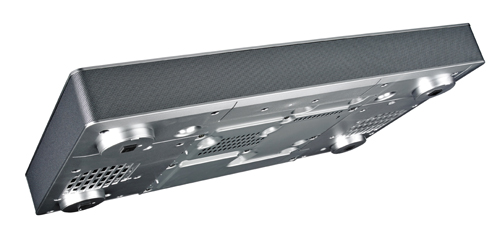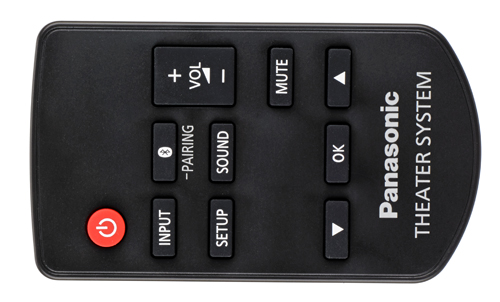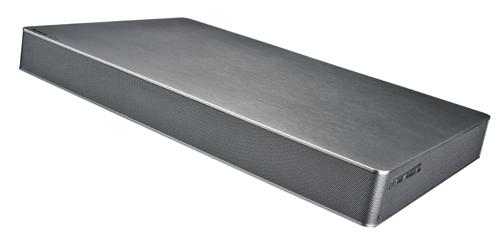What Hi-Fi? Verdict
Crisp, lean sound with good features, but a lack of bass weight spells trouble for this compact soundbase
Pros
- +
Crisp, clear sound
- +
Focused, lively delivery
- +
Easy to use
- +
Display
- +
Good variety of connections
- +
Smart looks
- +
Compact size and good build quality
- +
Price
Cons
- -
Lacking in solid, punchy bass
- -
Lightweight sound
- -
Treble can sound bright sometimes
Why you can trust What Hi-Fi?
We can see the Panasonic SC-HTE80’s smart looks and compact size looking at home placed under your TV.
But as neat and discreet as it is, we wish there was more oomph to this soundbase’s crisp sound.
Sound quality
We didn’t expect a huge amount of bass from the Panasonic SC-HTE80’s compact frame, but we did expect a little more weight than we got.
It sounds a bit lean next to the more rounded and balanced sound of the Canton DM 50 and Cambridge Audio Minx TV.
Detail is crisp and clear, though, and the overall sound is focused on the midrange and upwards. The treble has plenty of bite and sparkle, but doesn’t veer into harsh or sharp territory.
It can sound a touch bright when watching standard-definition TV, though, especially anything with canned laughter.
Dialogue is direct and easy to hear, although the Panasonic needs more subtlety to bring out the nuances in voices.
There are two integrated 8cm ‘woofers’ inside the SC-HTE80, but it can’t quite convey the deep and rich bass notes that would make it a more engaging listen.
The lightweight sound does mean the Panasonic has a fast, agile delivery. Songs streamed via Bluetooth sound lively, but can edge to brightness, and lack punch and depth.
Build quality

It’s smallest soundbase we’ve come across yet, and we suspect it’s no coincidence that the SC-HTE80 seems purpose built to support Panasonic’s own square TV stands.
It makes sense for Panasonic to keep it in the family, and its sturdy build will withstand most screen sizes (as long as the set weighs under 30kg).
If you own a TV with a wide stand, though, we suspect it would overhang quite a lot, and the SC-HTE80’s compact form might not provide enough support. (You could always stash it on a shelf under the TV, though.)
The build quality itself is impeccable, with the MDF casing coming in silver or black brushed-aluminium effect finishes. It’s a neat and tidy box, with discreet power and volume buttons on the side.
Features

Unlike many rivals, the HTE800 has a display. Large blue letters let you know which input you’re using, from TV (optical) to Bluetooth pairing, as well as the volume level.
The display makes it easy to access and navigate the Panasonic’s menus with the rather dinky remote.
There are plenty of options to tweak the SC-HTE80’s sound, starting with a much-needed boost in bass performance.
Activating H. Bass (Harmonic Bass) adds some much needed weight, but at the expense of clarity.
There are also six sound modes on offer. They’re worth experimenting with, but we’d suggest picking ‘Music’ when streaming songs via Bluetooth, and picking ‘Standard’ when watching broadcast TV or a film
Connectivity
There’s a decent selection of inputs on the SC-HTE80, with the addition of HDMI connections a tick in Panasonic’s favour.
An optical input seems standard on soundbases, but HDMI (one input, one ARC output) is rare to see in this first generation. Analogue connectivity is represented by a pair of RCA inputs.
The soundbase also supports NFC connectivity for swift, one-tap connection to your Android or Windows tablet or smartphone.
Along with ensuring Bluetooth is turned on, you will need to download the free Panasonic Music Streaming App for NFC-tapping to work.
Verdict
It’s a step up from tinny TV speakers for sure, but the SC-HTE80 doesn’t feel like the complete solution.
We’d like a more even balance across the frequencies, with punchier, more substantial bass for a fully satisfying sound.
It’s a smart-looking soundbase, though, and is a great size for those that don’t want yet another big box cluttering up their TV space or obstructing the view.
It does seem designed to be paired with Panasonic TVs only – which is rather limiting.
On the bright side, it’s a good, affordable price – £250 is a fair deal for what the Panasonic SC-HTE80 can do.
Pricier soundbases have disappointed with their lacklustre sound and frustrating use, but the Panasonic does face fierce competition from the talented Cambridge Audio Minx TV at £200.
What Hi-Fi?, founded in 1976, is the world's leading independent guide to buying and owning hi-fi and home entertainment products. Our comprehensive tests help you buy the very best for your money, with our advice sections giving you step-by-step information on how to get even more from your music and movies. Everything is tested by our dedicated team of in-house reviewers in our custom-built test rooms in London, Reading and Bath. Our coveted five-star rating and Awards are recognised all over the world as the ultimate seal of approval, so you can buy with absolute confidence.


